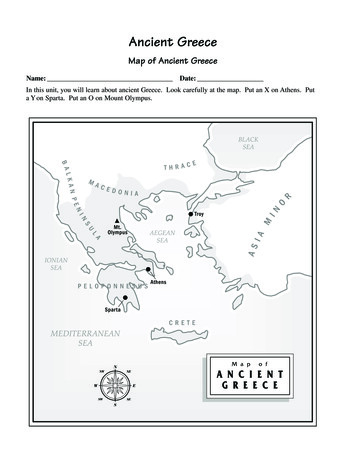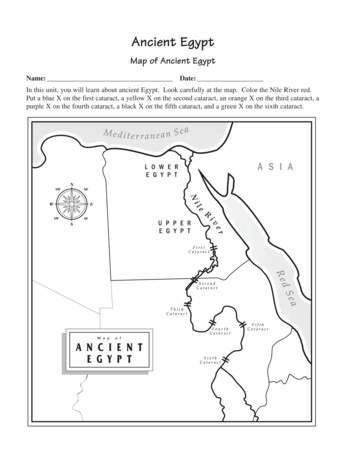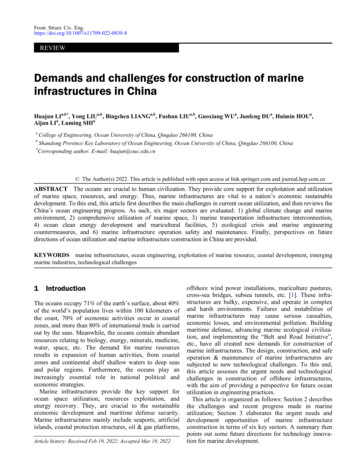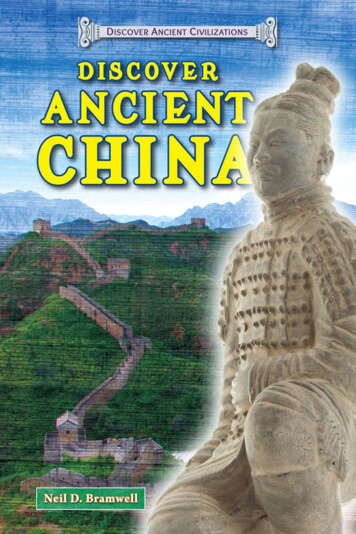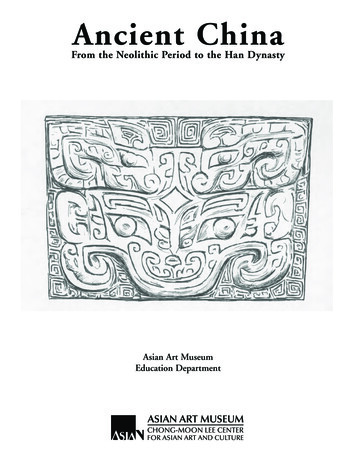
Transcription
Ancient ChinaFrom the Neolithic Period to the Han DynastyAsian Art MuseumEducation Department
Ancient China:From the Neolithic Period to the Han DynastyPacket written and illustrated byBrian Hogarth, Director of Education, Asian Art Museumwith generous assistance from:Pearl Kim, School Programs Coordinator, Asian Art MuseumMichael Knight, Curator, Chinese Art, Asian Art MuseumHe Li, Associate Curator of Chinese Art, Asian Art MuseumJohn Stuckey, Librarian, Asian Art MuseumLisa Pollman, Graduate Student, University of San FranciscoWhitney Watanabe, Graduate Student, University of WashingtonDeb Clearwaters, Adult Programs Coordinator,Asian Art MuseumRose Roberto, Education Programs Assistant, Asian Art MuseumPortions of this packet are based on lectures by Michael Knight and PatBerger at the Asian Art Museum, and particularly the writings of K.C.Chang, Tom Chase, Wu Hung, He Li, Robert Murowchick and Jessica Rawson.(For a complete list of sources, see bibliography)Photographs of Asian Art Museum objects by Kaz Tsuruta and Brian HogarthArchaeological photos courtesy of:Academia Sinica, Republic of ChinaChina Pictorial Service, Beijing, PRCCultural Relics Bureau, Beijing, PRCHubei Provincial Museum, Wuhan, PRCHamilton Photography, Seattle, WAAsian Art Museum, February 20, 1999
ContentsIntroduction: Studying Ancient ChinaHistorical Overview: Neolithic Period to Han DynastyArchaeology and the Study of Ancient ChinaCeramics, Jades and Bronzes: Production and DesignThree Tomb ExcavationsImportance of RitesSlide DescriptionsTimelineBibliographyStudent Activities
ANCIENT CHINAIntroduction–Studying Ancient ChinaThis teacher’s packet accompanies a school tour program of the same name. The tourprogram emphasizes ancient Chinese ceramics, bronzes and jades in the collections of theAsian Art Museum from the Neolithic period (ca. , – , ) through the end ofthe Han dynasty (ca. ) This packet complements an earlier one produced by theAsian Art Museum, Stonecutter, Metalsmith, Potter: Artists of Ancient China. Although there issome overlap between the two packets, this one emphasizes the broader historical contextsof the art objects on display, with archaeological, philosophical and technologicalperspectives.This packet contains historical overview of the main periods, as well as examples of threeimportant archaeological excavations from the . In the summer of the year , theAsian Art Museum will present a new exhibition of recent archaeological finds fromChina, The Golden Age of Chinese Archaeology. At that time, a supplementary guide featuringsome of the highlights of that exhibition will be added to this packet.Studying ancient China is like trying to hit a moving target. New archaeological discoveriesare frequently being made in China meaning that the histories are constantly beingrewritten. Another challenge is that, even when new finds are announced, it often takesyears for work and reports to be completed, and even longer for the results of this work toappear in English. The reader and student should be aware that much of what is writtennow will likely be revised before long.An important point to consider when dealing with the distant past is that there is muchthat we do not, and cannot know. The archaeological record is limited at best, and evenspectacular finds, such as those profiled in this packet, often raise more questions thananswers. Similarly, objects that appear in museum collections were usually collectedprivately as works of art appealing to the individual collector, rather than as historicaldocuments, or as attempts to fill in a historical record. They too, form a picturesque, butincomplete view of the past. It is the museum’s task, then, to try and fill in some of thegaps in the viewer’s understanding. The task of the student of Chinese art objects is tostudy the objects as products of an original cultural environment, without going too farinto the realm of pure speculation. In reading this packet, a distinction should always bemade between what is clearly evident, and what is interpreted or speculative. This point willcome up again in the slide descriptions and enclosed student activities.Some overall goals for this packet and program are: To explore the rise of ancient Chinese civilization, and how characteristics of thiscivilization are reflected in surviving examples of its material culture; for example, howobjects reflect belief systems and cultural values;To understand some of the technical and artistic breakthroughs achieved in ancientceramics, jade and bronze;To recognize the limitations and opportunities of interpreting historical objects,especially those excavated from tombs by archaeologistsAsian Art MuseumEducation Department
Defining “Ancient China”In this packet, Ancient China refers to the time between the Neolithic period, beginningabout , years ago, and the Han dynasty, which is roughly equivalent to the period of theRoman Empire in the West. This is the formative stage of Chinese civilization. During thistime, what we now call China developed from a collection of isolated cultural communitiesto a set of organized states which eventually coalesced around the idea of a single unifiedstate, and then expanded to include contact with other civilizations.The first step was the development of agriculture. This resulted in settled life whichproduced surplus or stored goods. As more and more cultures came into close contact, theneed for defence arose, and communities were walled in for protection. Societies becamestratified around rulers and subjects, with allegiances and authority based on clan lines.Organized warfare on a massive scale began. In its rise to civilization, China developed asystem of writing, various beliefs about heaven and the cosmos, as well as technologicalbreakthroughs that allowed for political control and economic expansion.The rise of civilization in China meant a gradual process of organizing disparate groupsaround a set of common beliefs, first by force, and then by articulating what it meant to beChinese. This self-consciousness of ‘Chinese-ness’ first occured during the Eastern Zhoudynasty ( – ) when a ‘hundred schools’ of philosophy debated everything from thenature of man to notions of proper conduct and the ideal ruler. This period was soinfluential that later dynasties would refer back to it as a measure of their own worth.Discussing Ancient China with studentsIn addition to the student activities enclosed in this packet, here are some suggestions ondiscussing ancient China with your students: Have students recreate the timeline, noting the long history of Chinese civilization, andthe importance of studying the history and culture of such a large portion of theworld’s current population ( . billion people); There is a tendency for children’s books on Ancient China to include everything beforethe modern era. Try to define the period as noted above; similarly, note the differencesbetween ancient customs and rituals and what the students see as characteristics oftoday’s Chinese cultures and communities; Use this packet to explore different dimensions of ancient China such as technolgicalinnovations; social and political developments, beliefs and practices as revealed throughburial sites, and artistic achievements; Before (using the slides) or after you visit the museum, ask the students to recreateaspects of ancient China that are suggested by the art objects on display: who madeand who used each object, where would these objects have been used; what sort of lifedid these people live, what was a typical day like? Having thought about the previous questions, how much of what the students imaginecan be gleaned from the art objects and written records of ancient China? What can besaid for certain about these things, and how much is speculation? How do differentscholars (ie archaeologists, art historians) use these objects to interpret the past?Asian Art MuseumEducation Department
ANCIENT CHINAHistorical Overview–Neolithic to HanThis booklet covers the time period between approximately , (Before CommonEra) and the end of the Han dynasty at (Common Era). This is an immenseamount of time, about two-thirds of the total span of Chinese history. It can be brokendown into the following periods and dynasties:Neolithic period*ca. , – ca. , Erlitou period**ca. , –ca , Shang dynasty:Erligang periodAnyang periodca. , – ca. , ca. , – ca. , Western Zhou dynasty***ca. , – Eastern Zhou dynasty:***Spring/AutumnWarring States – – – Qin dynasty – Han dynasty:Western HanXinEastern Han – – – – * The Neolithic period, or New Stone Age, is usually broken down into regional areas,such as North-eastern China, North-Central, Eastern, South-eastern and South-centralChina. Furthermore, each area can be broken down into earlier and later Neolithic cultures.See map.**The Erlitou period, named after the excavated site of an ancient capital, continues to bea source of debate. Some historians believe it to be the site of the ancient Xia dynasty.Others consider it to be the early stages of the Shang dynasty. Dates for the Erlitou,Erligang and Anyang phases of ancient China are also subject to debate. The period oftime from the Xia through the Zhou is often referred to as the Bronze Age in China.***Western and Eastern signify a change in the capital of that dynasty from west to east,for example from ancient Chang’an (Xi’an) to Luoyang. The Eastern Zhou is divided upinto several periods. During the Warring States, for example, power shifts to severalcompeting states. Zhou continues to rule as a puppet state while others jostle for power.The Qin eventually suceed in defeating all other states, uniting China for the first time.Imperial China begins at this point.Asian Art MuseumEducation Department
Overview of the Neolithic PeriodThe Neolithic Period is part of prehistory, which is usually broken down into two mainsections: Palaeolithic (Old Stone Age) and Neolithic (New Stone Age). The Neolithicbegins about , or , and ends with the Bronze Age around , , but as weshall see, bronzes emerge before the so-called Bronze Age. Dating is problematic andunresolved. For the purposes of simplicity, this period runs roughly between , and , . The Neolithic cultures discussed below have been divided by regions and as earlyor later Neolithic.It was originally thought that prehistoric communities first emerged in north central China,and then spread to other parts of China. The archaeological record, however, now suggeststhe simultaneous emergence of a variety of cultures across China, each with their owncharacteristics. Our discussion will be limited to some of the major cultures to emerge inNorth-central China and Eastern China, as these are reflected in the Asian Art Museumcollections.Our knowledge of the Neolithic period is based entirely on the archaeological record.Most of the evidence appears in the form of burials or cemetaries near encampments orthe remains of ancient villages. The Neolithic is characterized by the beginning of settledlife, brought on by agriculture. This coincides with the use of stone tools for farming, andthe fashioning of ceramic pots to store and cook the harvested foodstuffs. Therefore, mostof the objects found at these ancient grave sites are pots, and to a lesser extent, tools andother objects made of bone and stone. There is usually enough evidence to make someobservations about the historical environment. For example, sites often reveal bits offoodstuffs and discarded bones and shells that help indicate eating habits. We know that inmany cases, a diet based on domesticated plants and animals was still supplemented withhunting and gathering of food.The name of a culture is usually based on a single site which defines a distinct culturalgroup. For example, Yangshao is based on a village in Henan close to a site excavated firstin , even though the term can be applied to a vast area. Similarly, Longshan cultures arenamed after a single village in Shandong province, even though a variety of Longshancultures exist across China in the later Neolithic period. The names given to these groupsare of course modern appelations, and we do not know what the original peoples calledthemselves until we reach the historical period.According to K C Chang, who has written extensively on ancient Chinese archaeology(Chang, ), China was very moist and much greener in prehistoric times. The evidenceof animal remains, soil samples from archaeological sites, and the imagery used on ancientceramic vessels, suggest a more tropical, forested environment throughout China. Animalsfound in north-central China at this time would have included water buffalo, bamboo rat,elephants, tapirs, water deer–animals normally associated with a more southern climate.Some of the earliest domesticated animals appear to have been dogs, pigs, and waterbuffalo; pig remains turn up most often. In the north, farmers raised millet crops, hempand cabbage. Some of the earliest remains of farming are found at the sites of Peiligangand Cishan. In the south, rice was the main crop, with some of the first evidence showingup in the middle reaches of the Yangzi river. Along the east coast, there is evidence ofbottle gourds, acorns and water chesnuts. Cord was made from a nettle plant known asramie.Asian Art MuseumEducation Department
Ancient China–Early Neolithic CulturesAsian Art MuseumEducation Department
North–central/North west–Yangshao/Majiayao CulturesThe group of sites and associated cultures of the north central plains in early Neolithictimes are collectively known as Yangshao cultures. This is the group most oftenrepresented in western museum collections of Asian art, since it was the area first collectedby western and Chinese archaeologists in the first half of this century. The pottery fromthis group is distinguished by a variety of painted designs, hence the term, ‘paintedpottery’ cultures.Some of the major phases represented by pottery from this group are, listed from earliestto latest:Yangshao–Banpo phase (ca. , – , )Miaodigou phase (ca. – , )Miaodigou II phaseMajiayao phase* (ca. , – , )-Banshan type-Machang type* some see this phase as a separate cultural groupSlide # 1 in this teacher’s packet is one of the oldest pieces in the Asian Art Museum’scollections, a small painted bottle from Banpo.This site is quite well known to tourists, asit is often seen on trips that include the First Emperor’s tomb outside of present-day Xian.Banpo was a large fortified village along the banks of the Wei river. The use of slash andburn agriculture meant that the villagers would have abandoned the site after a short time(Chang, 1986). An unusual feature of this site is the presence of children buried in urns,usually beneath the houses or within the walls of the habitations. Adult bodies were buriedoutside the village, which was surrounded by a ditch. Houses were made with woodenpoles plastered with mud. Inside each house was a hearth for cooking, and benches orraised areas possibly used for sleeping. The layout of the homes suggests some kind ofsocial organization, with larger houses surrounded by smaller ones.An interesting development in the Majiayao phase burials is the separation of men’s andwomen’s graves, men buried with stone tools, and women buried with spindle worls andpots. During this period, it is suggested that there was a transition from matriarchal topatriarchal forms of society (He Li, ).Yangshao potteryYangshao pottery is characterized by the use of reddishearthenware painted with black decorative designs. Thesedesigns change from site to site, moving fromrepresentational art to more abstract designs. In someinstances, the designs resemble mask shapes with fish-likeprotrusions, in others, the designs are swirling patterns with atooth-like pattern (see illustration). Some % of Banshanpottery is painted. Tripod vessels used for cooking (ding)appear at this time, and a lot of basket and cord impressionssuggest a sophisticated level of fabric and basket technology. Banshan VesselAsian Art MuseumEducation Department
North–east –Hongshan CulturesSome of this century’s earliest archaeological work in China was carried out by theJapanese in north-east China. Hongshan cultures flourished between , – , , inthe hills above the Manchurian plain bordering the grasslands of Mongolia (Liaoningprovince). Hongshan finds include some of the earliest jades used as pendants, traces ofbronze casting, larger-than-life female statues, and cist tombs marked by slabs. Some wellknown jades from this culture are the so-called ‘pig dragons’ that were placed on the chestof tomb occupants. Perhaps most interesting is the presence of central stone altar areas,suggesting that the Hongshan built some of the earliest temple structures in ancient China(Lei, ).East Coast – Dawenkou, Hemudu, Majiabang, LiangzhuTraveling south from the area of Hongshan cultures, we encounter sites of the Dawenkoucultures (ca. , ‒ , ) in what is now Shandong and Jiangsu provinces. Peoples ofthis culture used finely polished stone tools and built complex pottery forms, usually greyand black. Whereas Yangshao and Majiayao cultures are distinguised by the frequent use ofpainted designs, east coast cultures appear to have emphasized form over decoration.Dawenkou vessels show several advances, such as the use of the wheel and firing techniquesto achieve very thin, delicate wares. Increased social stratification occurs in Dawenkou sites,where some graves have wooden coffins with goods, some with only goods, and others withno grave goods. Pig heads turn up in some of the larger graves. Perforated turtle shellsappear, a precursor to the oracle bones used in divination we shall see later in the Shang.Hemudu (ca. , – , ) and Majiabang (ca. , – , ) cultures inhabit theareas south and north, respectively, of Hangzhou Bay on the central east coast of China.The late phase of Majiabang is known as Songze. It is hard to know the exact range ofmany of these cultures, often named on the basis of a single site. Hemudu, for example, innothern Zhejiang province, reveals many interesting finds. These include joinery found inthe remains of timber buildings, evidence of rice cultivation, blackware pottery, hoes madeof animal shoulder blades, and one of the earliest lacquered bowls found in China.Majiabang cultures, to the north of Hemudu, also incorporated mortise and tenon jointsin their habitations. Bones of boar, elephant, deer, turtle, fox, alligator, fish, and molluskappear, indicating the importance of hunting wild game. Tools include hoes made ofanimal shoulder blades, items made of bone, antler and stone, and ring-shaped jades.Domesticated animals include dogs, pigs, and water buffalo. Burials are usually single, withheads facing down and pointing north.LiangzhuOne of the most remarkable cultures to emerge slightly later along the east coast is knownas Liangzhu (ca. , – , ) located in the area around present-day Shanghai, andpossibly a later outgrowth of Majiabang/Songze cultures. Originally, it was felt that thiswas another branch of Longshan culture, but it is now seen as an independent culture.Liangzhu has been studied at nineteen sites in Zhejiang province.Asian Art MuseumEducation Department
Ancient China–Late Neolithic CulturesAsian Art MuseumEducation Department
Like the Dawenkou, Liangzhu culture showed a preference for black pottery waresproduced on the wheel. Most importantly, the Liangzhu are known for their jade work.This consisted of ornaments, ritual weapons and ritual objects known as bi and cong. (Seeslides # , for further details). Jade was used as an indication of status in burials (basedon the time required to produce such quantities), or it may have had religious or symbolicsignificance. The development of surface design motifs on Liangzhu jades may haveinfluenced the later art of the Shang dynasty.Later Neolithic cultures–LongshanLongshan is a term originally based on a site in Zhangqiu, Shandong province, discoveredin , but now applied to three major areas of later Neolithic cultures, all approximately , – , :Shandong Longshan (eastern China)Henan/Hebei Longshan (central China)Shaanxi Longshan (north central China)The Longshan period is represented in this packet by slide # , a very delicate goblet madeof egg-shell thin black pottery from about , – , .Generally, this later Neolithic period is characterised by the emergence of copper objects,increased use of the potter’s wheel, a general decline in painted pottery, the use of stampedearth walls for defence, indicating an increase of violence and stratification of society, plusthe use of jade ritual objects and bones for divination. Cultures were becoming morecomplex and diversified. The archaeological record shows increased contact betweencultures (Chang, ).Social stratification is best exemplified by a large cemetary at the site of Taosi, in southernShanxi province. Here, over a thousand burials have been studied. They have been dividedinto three types: large graves, medium graves, and small graves. One large gravecontained items, including red pottery plate with a dragon design, a wooden drumwith crocodile skin, music stone, drum-like pottery, wooden table, stand, various vessels,jade, stone rings, axes, and a whole pig skeleton. (Chang, )At the site of Hougang, Hubei province, five layers of bodies, apparently scalped, weredropped in a well. There is a circling wall of stamped earth. Both the well victims and thecircling wall suggest an increase in violence and the need for defence. Pig bones account forroughly % of domesticated animal bones at the site. Pig and deer shoulder blades wereused as oracle bones.The Transition from Late Neolithic to the Bronze AgeThe late Neolithic appears to be a crucial time in Chinese history when new technologies,new ways of organizing society, and increased contacts between cultures occured. Socialstratification, as seen in burial sites and grave goods became even more pronounced as thedynastic period began. Certain objects such as jade, moved beyond utilitarian purposes toacquire special significance associated with the ruling elite. This process now extended tobronze, in particular bronzes cast as ritual vessels.Asian Art MuseumEducation Department
The next period is referred to as the Bronze Age, or the period of the three foundingdynasties (sandai): Xia, Shang and Zhou*. We know about these early dynasties through avariety of sources– partly through legend, through historical records from several centurieslater, and more recently, from the archaeological record. What makes this period so excitingfor archaeologists is that much of what has been found in this century actually confirmsthe earlier historical records, turning what was assumed to be legend into fact.A later text from the Eastern Zhou dynasty, the Zuo Zhuan, ( ) testified to theimportance of bronze technology as an instrument of power in a famous quotation: “theprincipal affairs of the state are rituals and warfare”. The Bronze Age was alsocharacterized by the development of a writing system, larger urban centers with templestructures, more specialized industries, and the mobilization of larger armies. Royallineages would now become a key element in political structure of the state, and towns andvillages would be organized along feudal lines into guo (vassal states or kingdoms).Legendary rulers and the question of the Xia dynastyLater Chinese histories speak of a number of legendary rulers. These rulers are treated likefact for most of Chinese history, and are often depicted in works of art, for example onWu Liang’s tomb carvings from the Han dynasty. After a period of creation, and theformation of the various elements, three sovereigns and five emperors emerge. Shenonginvented agriculture. Fu Xi, the common ancestor, invented writing, hunting and fishing.Huangdi invented government and Daoist philosophy, and his wife introduced silkspinning. These ‘three cultural heroes’ are followed by the last of the model emperors, or‘three sage kings’–Yao, Shun and Yu. Yu is credited with controlling the floods, andfounding the Xia dynasty. In a symbolic gesture, Yu casts nine bronze vessels (ding), eachrepresenting one of the regions at that time, and these are passed to succeeding dynasties asa way of legitimizing the right to rule. Xia begins on a high moral note, but concludeswith a decadent king, who falls to Tang, the founder of the Shang dynasty.Solid evidence for the existence of the Xia dynasty is still under debate. Where was itlocated for example? Some scholars arguing that remains found at Erlitou, Henan province,are the site of Xia; other groups arguing that Erlitou is early Shang, depending on how thevarious layers or strata of excavations are interpreted. It seems possible, given thecompliance of Chinese histories and current archaeology of later Shang sites, that the Xiadid in fact exist, but we may not be sure, anytime soon, of their exact whereabouts in termsof material remains. The controversy is likely to continue, given that there are about thirtyreferences to Xia places in the traditional histories, and that the Shang are indicated ashaving overtaken the Xia. At this point, it seems safer to speak of an Erlitou phase orculture, arising out of the Henan-Longshan culture, leading to a more definable Shangperiod at several other sites.* Xia is pronounced ‘shee-ah’, and Zhou is pronounced ‘joe’.The Shang DynastyThe Shang dynasty extends from roughly , to , . According to various historiesand traditions, the Shang people originated along the middle and lower reaches of theYellow river. They defeated the Xia under the king Chengtang and established a number ofcity states. The Shang have been known in the archaeological record from around ‒ ,Asian Art MuseumEducation Department
when oracle bones drew attention to the site of Anyang, revealing the last capital of theShang, and confirming the existence of the dynasty. Since then, the period has beendivided into two main stages known as Erligang and Anyang. It is believed the Shangmoved their capital at least five times, and several dozen Shang sites have been identified.At this point, however, the best known sites are at Anyang and Zhengzhou.ErlitouErligangAnyang-either Xia or early Shang?-represented at Zhengzhou, middle stage-last capital of the ShangOne of the important factors in determining the history of the Shang is the presence ofwritten records. Writing at this time was mostly pictographic, meaning that a word wasrepresented by a picture that closely resembled its meaning. Overtime, this writing wouldbecome more ideographic. During the Shang, there were scribes who recorded importantevents. What has survived are inscriptions on bronzes, and more importantly, inscriptionson oracle bones used by the Shang for divination. Thousands of bones have been recovered,many of them broken. The bones contain not only intriguing questions about what willhappen and whether or not certain actions are bound to be effective or not, but also thenames of kings. We know, for example, the names of the kings that ruled for a period of years at Anyang.The oracle bones attest to the importance of ritual divination among the Shang rulers. Theoracle bones were used to divine, or determine, answers to various questions concerningagriculture (ie the success of a particular harvest), military expeditions, future events suchas pregnancies or military engagements, and very personal matters such as what to do abouta toothache. The questions, answers and outcomes were all recorded on the bones, usuallyplastrons and scapulae of cattle and turtles. A metal rod, or perhaps a burning ember washeated and placed on the bone near where the question had been written. The shape of thecrack determined the answer, and the outcome (what followed) was sometimes written onthe bone.Shang kings maintained a tightly controlled state. They acted not only as priests, but alsowaged military campaigns and controlled numerous workshops for producing ceramics,bone objects and most importantly, bronzes. Cowrie shells, an imported item, were used ascurrency. The technological advances in the production of bronze did not benefit theaverage person. Bronze was produced for the ritual and military needs of the state. Thecasting of bronzes was a laborious process, involving the mining of copper and tin, or leadores, smelting these into ingots, and then transporting the ingots to the bronze castingworkshops. Finally, bronzes were produced with intricate designs using ceramic piecemolds. The bronze industry was therefore a complex enterprise involving massive humanand material resources. K.C. Chang has suggested that the movement of Shang capitals mayhave been influenced by the continual search for new sources of copper and tin.(Chang, )The Shang aristocracy were buried in lavish tombs. Those at Anyang are typicallycruciform in shape, with one to four ramps leading down to the coffin at the bottom.Although plundered, there is enough evidence to show that coffins were lacquered, andsometimes inlaid. Beneath the coffin was a sacrificial dog or human, or series of humansacrifices surrounding the coffin pit area or on the ramps. Sometimes, the sacrificial victimswere beheaded. Whole chariots were buried with the owner. A large tomb, # , fromAsian Art MuseumEducation Department
Anyang is seen in slide # . One of the few tombs to survive untouched by looters isTomb no. , be
fact for most of Chinese history, and are often depicted in works of art, for example on Wu Liang's tomb carvings from the Han dynasty. After a period of creation, and the formation of the various elements, three sovereigns and five emperors emerge. Shenong invented agriculture. Fu Xi, the common ancestor, invented writing, hunting and fishing.



